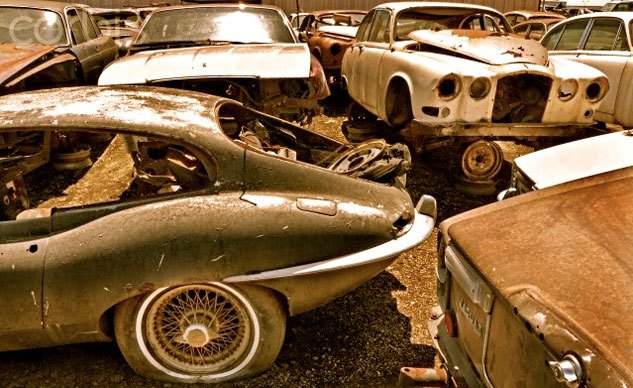Whatever! - Aiding and Abetting the Entropy
The more stuff you know how to fix, the more things fall apart. Before I started keeping not one but two flat tire repair kits on hand and a shiny new air compressor, I never got flats. Now I seem to pick up about one nail per vehicle per week. I took the old Ranger truck in to have a tire patched the other day when I couldn’t make a plug work. The next morning, the same tire was flat again. Oh, said the dude at Pep Boys upon my return, after a little investigating – there were two nails in there. Sorry.
Another very cool part of the digital revolution and Google and YouTube is the ability to repair all kinds of weird things around the house you formerly needed to call in a professional to fix. I’ve now fixed two (2!) refrigerator ice makers by replacing the solenoid valves on back that let the water in, along with two in-door water dispensers that suddenly became incontinent. (The latest fridge retaliated by refusing to keep things cold; an expert had to be called in to replace the compressor). Vacuum cleaner belts are like qualifying tires around here. Clothes dryer and BBQ grill igniters give up their spark too soon, computerized hood fans above the stove refuse to spin. I can break down and clean my lawnmower carburetor in the dark while returning enemy fire. The XR400 still won’t start.
To fill the time we get from increased productivity, we engineer more complicated products to keep us busy. I remember thinking what a great thing it was when the plastic ice cube tray replaced the old aluminum ones.
My ’97 Jaguar XJ6 is by far the nicest $5000 car I’ve ever owned despite the slow leak in its right rear tire – $5k pretty much being the upper limit for any vehicle I’ve ever bought since I started driving, regardless of the consumer price index. (I’ve got a great tagline in case you know any Jag marketing people: Nothing depreciates like a Jaguar!)
I didn’t really need or want a six-way adjustable power seat with memory, but that’s how they’re able to charge $55K for a car, I suppose. When the thing stopped working a couple months ago, I was glad it at least froze where it fits me. I remember a friend’s old 7 Series BMW a few years ago; when its passenger seat started losing its mind, it tried to swallow me like a giant clam as we were rolling down the 405. German engineering tends to err on the aggressive side.
My 6-foot tall kid could barely squeeze into the Jaguar though, and he complained enough that it made it difficult to wait the traditional grace period for the thing to fix itself. (Just think how much Jaguar could charge for a car that has manual back-up seat adjusters!) The wiring diagram for this automobile might as well be for an Airbus 380 far as I can tell, but it was the good old Jaguarforums to the rescue once again: To see if it’s the controller that’s at fault or not, swap in the one from the passenger seat. Why didn’t I think of that? Well I did, but the forum had pictures showing where the thing was located and how to remove it. In the video age, I need things spelled out. And photos.
Anyway, what worries me is, what happens to all our stuff when the number of replacement parts exceeds the capacity of the world’s storehouses to contain them? People loved to restore Hondas for years because you could still get parts for any one ever made. I don’t know if that’s still the case, but my Jaguar’s only 18 years old and the power seat control module is already out of production. Judging from the number of people on forums who’ve replaced them (a lot), I won’t be surprised when my new used one (which is older than my old dead one) gives up the ghost. What then? Will you just have to junk the whole automobile at that point, or will the hundred other electrical subsystems also gone haywire by then have caused you to junk it years ago? Should I buy back-up modules now, guaranteeing the crankshaft will snap next week?
The one business I found online that claimed to be able to repair the seat’s black box never returned my email. How would all the TV shows that find and restore old cars even get off the ground if Wayne Carini couldn’t even adjust the driver’s seat enough to be able to climb in and roll the thing onto the flatbed? Will electronic black boxes of the future found in desert junk yards plug into ancient wiring harnesses and work after a little beadblasting and powdercoating? Can you powdercoat plastic?
I know you know where I’m going with all this: I dig all the electronics on the new motorcycles, especially Traction Control(!) and ABS, but I can’t help worry who’s going to keep all this stuff in stock as it changes from year to year, when it goes the way of all electrons. Which it will, as everything electronic sealed in a black plastic box eventually, inevitably does. Jaguar is not a big seller of cars, but I’m going to bet they sold more XJ6s than Ducati will sell Multistrada S’s. I am worried that little Billy might someday master the fork seal driver and the eternal mysteries of the cartridge fork, only to have it all come to naught when he can’t find the right Skyhook control module for his 2014 Multistrada 20 years from now. Will there be a work-around? Will a cottage industry spring up to repair or manufacture new modules?
For now, I am thankful I don’t know how to weld: You know important structural things would start cracking all around me if I did. Sometimes I can relate to the old Bob Seger lyric: Wish I didn’t know now what I didn’t know then.
Any old business? Only this. A column or two ago, I went off a little about how widely divergent different people’s opinions of the same motorcycle can be, specifically after the Yamaha R1M won both big U.S. print magazines’ superbike comparos. We MOrons tested the non-M R1, minus the electronic suspension and some other things, and ranked it mid-pack overall in our six-superbike shootout. Anyway, it got me curious, and I checked with our Yamaha PR person as to how many R1Ms will be imported to the USA? The official word is “less than 500 for the U.S. market,” which are already sold out.
One big magazine named the base R1 its “Motorcycle of the Year,” while the other picked the R1M as one of its Ten Best. Well, they’re great motorcycles, and congratulations to Yamaha and to the fewer than 500 Americans who snagged one of the $21,990 “M”s. But I think we’re all proud of our Motorcycle of the Year pick here at MO, where we’ve been attempting to keep it somewhat real since 1994: The Indian Scout. Rock on.
More by John Burns








































Comments
Join the conversation
I once replaced a fuse on my bike when an air compressor overloaded the circuit. Other than adding air to tires, that's the extent of my wherewithal to repair or maintain anything. As such, I look forward to the day when technology advances to the point where no one else can fix anything either. Lol!!
I fear artificial intelligence will soon render human beings superfluous with respect to many tasks. Then what will we do?
" I remember a friend’s old 7 Series BMW a few years ago; when its passenger seat started losing its mind, it tried to swallow me like a giant clam as we were rolling down the 405. German engineering tends to err on the aggressive side."
I almost peed my pants.